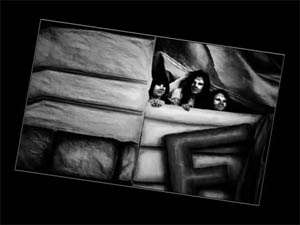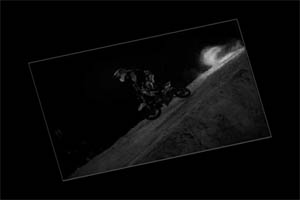articles/Art/chroniclesmood-page3
Chronicles from the World of Mood - part 3 of 1 2 3 4
by Ruben Buhagiar Published 01/10/2009

What you see is what you get - right?
Wrong! 'Looking'is one thing; 'seeing' is quite another. Two people can look at the same thing and one will see a great deal while the other will see nothing, or rather, nothing of interest to them. This situation is analogous to an experienced detective in a crime scene finding numerous clues when the average man on the street would have overlooked them. The difference between seeing and not seeing is insight. Insight is that element that separates the great photographers from the ordinary ones. When you gain further understanding and insight into the subject matter you're photographing, you'll create photographs that progressively penetrate deeper into the essence of the subject. More importantly, you gain an insight into your own areas of interests - what excites you, why it excites you and how it excites you. You will be discovering yourself.
A further point on this. Consider a scene, or scenario which you feel compelled to immortalise in a photograph. It is already a headache to transmit what you are seeing in the digital medium (the image), because I am sure you'll agree on the numerous occasions we were disappointed that what you saw was not what you captured. To add to these profound differences, these actual differences are rendered even more profound due to the fact that your response to the scene also depends on the non-visual sensory input not present into your image. It includes the sounds, smells, temperature and breezes, the feel of things near you, as well as your state of health and your state of mind at the time. None of these things are visual, yet they all contribute to your reaction to the scene. So how can you possibly distill all this sensory input into an 20x16 two-dimensional image (which could also be black and white) with any hope of capturing the original? In a very real sense, it cannot be done! The photograph is distinctly different from the scene, and as a result, it is foolish to attempt to 'capture the scene'. Instead, attempt to convey the mood that the scene has impressed upon you.

Catching the atmosphere
But how does one capture emotion in a photograph? What is emotion or mood? Emotion in photography is thoughts, feelings, and ideas conveyed in a split second (the instant the photo was taken) that elicit the same or similar thoughts, feelings or ideas from the viewer. Sound complicated? In some ways it is, in others it is just a matter of common sense. In others, it just comes naturally.
The first step to improving the mood of your photographs is to simply stop and look around you. What do you see? Are there people moving quickly around you? Anyone sitting still? What demeanor does that person have? Is he smiling, frowning, or watching the sunset? All of these emotions can be captured on film, and can portray entirely different moods. Different expressions, varying angles and different viewpoints can help to achieve emotion in images.
Another effective tool for achieving mood or tone of a photograph is the use of colour. Bright contrasting colours give a sharp, hard hitting mood, while soft muted colours can give a sad, nostalgic or even romantic tone.
Another way to invoke emotion is through the use of black and white photography. Black and white is perhaps the most creative medium available in photography. It can be used to convey many tones: classy, timeless, modern, and poignant are just a few. An image shot in colour might appear to be a completely different image when presented in black and white.
Another way to infuse a photograph with emotion is to pay attention to the lighting conditions. A photograph taken in low light will present a much softer, more muted tone than one taken in the midday sun. The same principle holds true for overcast skies and low lighting indoors. Another aspect of lighting is to watch for shadows. The shadows cast during midday will be different to those of the morning or early evening.
Different types of filters can be used to convey various tones or moods as well. A diffusion filter can be used to soften edges on images, giving a romantic tone. A polarizer can make colour saturation appear deeper, and coloured filters used with black and white film can make overcast skies look quite sinister. There are many different filters on the market ranging from magnifying to every colour of the rainbow. There is even one that has a rainbow on it so you can add a rainbow to your landscapes!
Technical skill is certainly important, and as more and more sophisticated equipment becomes available on the market it will continue to be an important part of photography. But infusing your photographs with emotion will make your photographs all the more distinctive and you'll be able to take greater pride knowing that you captured that elusive shot, that special photograph which no one else has.
A word about technology and photography
Today, technology helps us out because it has brought photography to the people, but it is wrong to think that now that you have a sophisticated digital camera then you have become a photographer. A computer is a tool, nothing more, nothing less. A camera is a tool. A darkroom is a tool, nothing more, nothing less. A paintbrush is an artistic tool. A pencil is one, too. A computer will not turn the average person into an artist any more than any of the other tools will do so. It's the mind behind the tool that creates art, not the tool. Those who think they will make an artistic breakthrough by approaching photography through digital methods, are in for a tremendous surprise. It would be like thinking that by going to a pen you'll become a better writer than you have been through the use of a pencil.
Another cliche is that now art is more available because it has become more convenient. That's fine if it keeps you in photography, but it should be noted that none of the great work in photography was done when it was 'convenient.' It was done by people who were committed to self expression, by people who put other things aside to do photography because it was so important to them. This is a fact and I am pointing this out because this convenience attitude is a great atmosphere- or mood-killer. Work will be produced in times of convenience, but it won't be outstanding work. The people who will do great digital work will be as artistically visionary and as committed to it as the great photographers of the past and present who have been committed to their work. People doing it on a 'convenience' basis will not produce much of lasting value. None of this should be surprising. Great work in any field-artistic, scientific, business, etc - is always done by people who are driven, are committed, are enthusiastic, and are totally involved. Einstein did not create his revolutionary theories in times of convenience. Picasso did not create his great paintings when it was convenient. They - and all others who have been creative - put everything else aside to do their great work, and their lives were fully devoted to these endeavours. But how many who are doing photography have the illusions that you (or me) are in the league with Ansel Adams or Edward Weston, or any of the other 'greats' in the history of photography? Probably very few of us. So what's wrong with doing work when it's convenient? Nothing! In fact I would have to concede immediately that if it does, indeed, keep you in the game, in your hobby, in your passion, and it allows you to proceed with your passion when you have the time to do it, then go for it! If digital allows you to proceed with your photography when you have the chance in your busy life (and all of our lives seem busier than we would like them to be) then digital may be the answer. I'm simply saying that if you aspire to be an Adams or a Weston, don't expect digital convenience to get you there.
Please Note:
There is more than one page for this Article.
You are currently on page 3
- Chronicles from the World of Mood page 1
- Chronicles from the World of Mood page 2
- Chronicles from the World of Mood page 3
- Chronicles from the World of Mood page 4
1st Published 01/10/2009
last update 21/07/2022 08:49:43
More Art Articles
The Society of Photographers Convention and Trade Show at The Novotel London West, Hammersmith ...
You have 29 days until The Society of Photographers Convention Wednesday 14th January 2026





